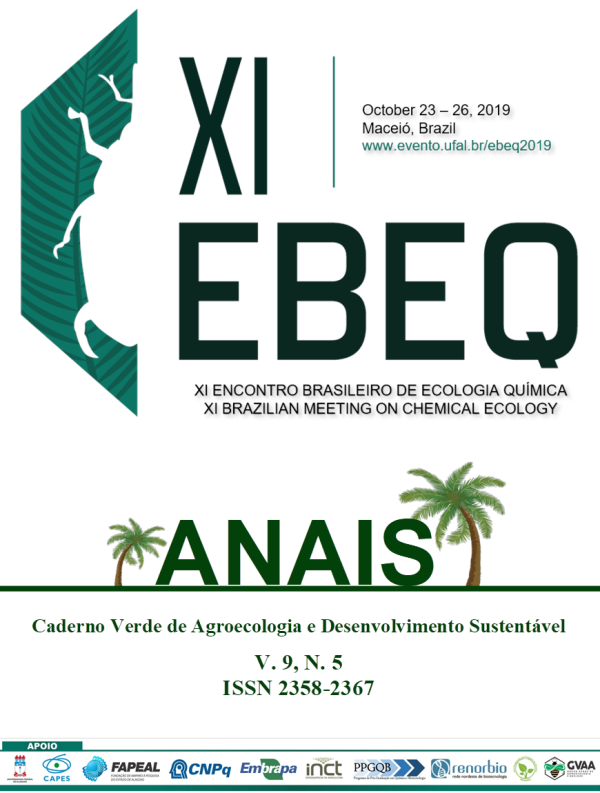SECONDARY CHEMISTRY EFFECT OF Eucalyptus spp. ON THE FEEDING PREFERENCE OF Thaumastocoris peregrinus (HEMIPTERA: THAUMASTOCORIDAE)
Palavras-chave:
Eucalyptus, BRONZE BUG, METABOLOMICSResumo
The bronze bug, Thaumastocoris peregrinus, a relevant pest of eucalyptus crops, is a native insect from Australia whose first presence was recorded in Uruguay in 2008 and in other countries even before. T. peregrinus feeds on eucalyptus leaves, piercing and sucking the sap, causing the loss of photosynthetic surface area, defoliation, and even tree death. In this work, we present the results of feeding preference tests among four eucalyptus species that are present in Uruguay and not previously reported. Mated females were offered the option of 2 leaf pieces (6cm2 each) and the number of fecal drops (72h) was recorded. A feeding preference index (FPI) was calculated as: FPI=Number of fecal drops on leaf 1/Total number of fecal drops. Besides, secondary metabolites from the leaf parenchyma of the four species tested were extracted with dichloromethane/H2O and a mixture of CDCl3/D2O. These extracts were analyzed by GCMS (dichloromethane extracts) and 1H-RMN (CDCl3 and D2O extracts). From the preference tests, species were classified as non-preferred (E. robusta), intermediate (E. globulus) and preferred (E. tereticornis, E. grandis). The metabolomic analyses run on a joined matrix (26x4545) of the 1H-RMN data showed that the four species can be differentiated (Random forest classification showed excellent prediction of species, with a 0% out of bag (OOB) error rate). A subsequent analysis incorporating the preference classification also showed differences among secondary metabolites (Random forest, 0.04% OOB error rate). The metabolites with higher variable importance in this analysis are still under investigation. The GCMS results showed that the four species are differentiated by their content of 1,8-cineol and p-cymene, 2 metabolites previously correlated with the resistance/preference in other species (ANOVA, with post-hoc comparisons p<0.0001): while p-cymene was up-regulated in the preferred E. tereticornis (0.6mg/100mg of leaf), 1,8-cineol was in the intermediate specie (E. globulus, 3.2mg/100mg).
Downloads
Publicado
Como Citar
Edição
Seção
Licença
Termo de cessão de direitos autorias
Esta é uma revista de acesso livre, em que, utiliza o termo de cessão seguindo a lei nº 9.610/1998, que altera, atualiza e consolida a legislação sobre direitos autorais no Brasil.
O(s) autor(es) doravante designado(s) CEDENTE, por meio desta, publica a OBRA no Caderno Verde de Agroecologia e Desenvolvimento Sustentável, representada pelo Grupo Verde de Agroecologia e Abelhas (GVAA), estabelecida na Rua Vicente Alves da Silva, 101, Bairro Petrópolis, Cidade de Pombal, Paraíba, Brasil. Caixa Postal 54 CEP 58840-000 doravante designada CESSIONÁRIA, nas condições descritas a seguir:
O CEDENTE declara que é (são) autor(es) e titular(es) da propriedade dos direitos autorais da OBRA submetida.
O CEDENTE declara que a OBRA não infringe direitos autorais e/ou outros direitos de propriedade de terceiros, que a divulgação de imagens (caso as mesmas existam) foi autorizada e que assume integral responsabilidade moral e/ou patrimonial, pelo seu conteúdo, perante terceiros.
O CEDENTE mantêm os direitos autorais e concedem à revista o direito de divulgação da OBRA, com o trabalho simultaneamente licenciado sob a Licença Creative Commons do tipo atribuição CC-BY.
O CEDENTE têm autorização para distribuição não-exclusiva da versão do trabalho publicada nesta revista.
O CEDENTE têm permissão e são estimulados a publicar e distribuir seu trabalho online (ex.: em repositórios institucionais ou na sua página pessoal) a qualquer ponto antes ou durante o processo editorial, já que isso pode gerar alterações produtivas, bem como aumentar o impacto e a citação do trabalho publicado.










